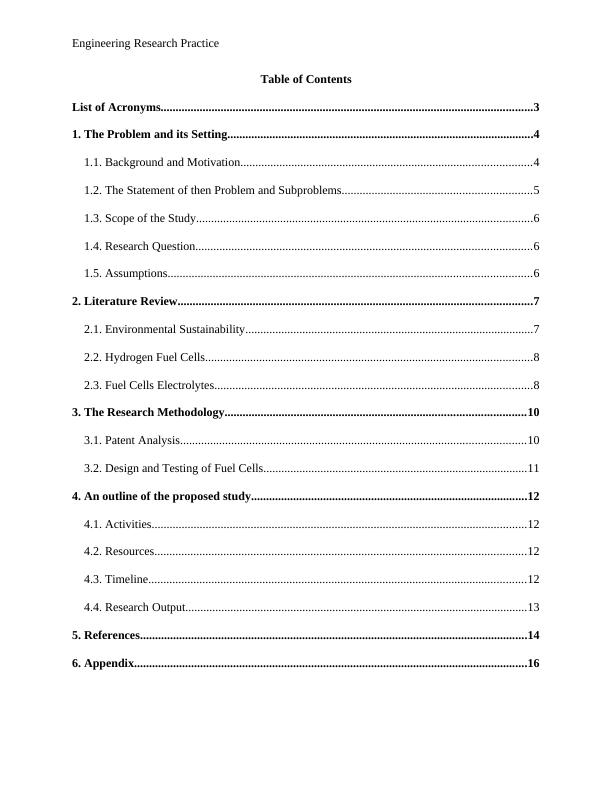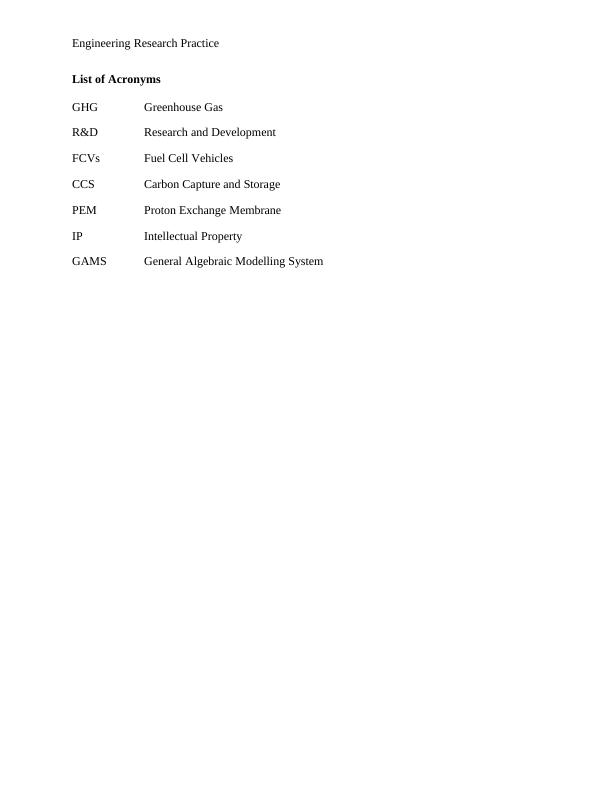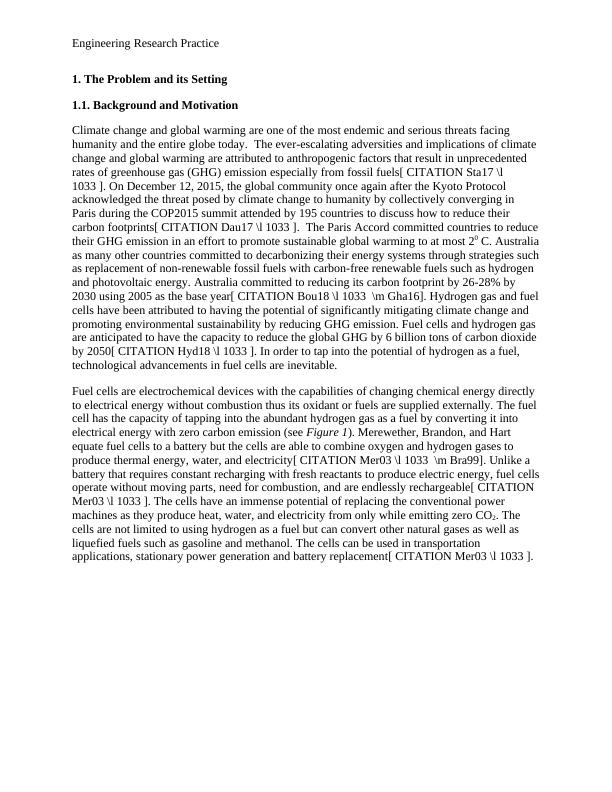Engineering Research Practice PDF
Added on 2021-10-16
17 Pages4665 Words39 Views
Name of student
ID
Engineering Research Practice
Assignment 3: Research Proposal
ID
Engineering Research Practice
Assignment 3: Research Proposal

Engineering Research Practice
Table of Contents
List of Acronyms............................................................................................................................3
1. The Problem and its Setting......................................................................................................4
1.1. Background and Motivation.................................................................................................4
1.2. The Statement of then Problem and Subproblems...............................................................5
1.3. Scope of the Study................................................................................................................6
1.4. Research Question................................................................................................................6
1.5. Assumptions.........................................................................................................................6
2. Literature Review......................................................................................................................7
2.1. Environmental Sustainability................................................................................................7
2.2. Hydrogen Fuel Cells.............................................................................................................8
2.3. Fuel Cells Electrolytes..........................................................................................................8
3. The Research Methodology....................................................................................................10
3.1. Patent Analysis...................................................................................................................10
3.2. Design and Testing of Fuel Cells........................................................................................11
4. An outline of the proposed study............................................................................................12
4.1. Activities.............................................................................................................................12
4.2. Resources............................................................................................................................12
4.3. Timeline..............................................................................................................................12
4.4. Research Output..................................................................................................................13
5. References.................................................................................................................................14
6. Appendix...................................................................................................................................16
Table of Contents
List of Acronyms............................................................................................................................3
1. The Problem and its Setting......................................................................................................4
1.1. Background and Motivation.................................................................................................4
1.2. The Statement of then Problem and Subproblems...............................................................5
1.3. Scope of the Study................................................................................................................6
1.4. Research Question................................................................................................................6
1.5. Assumptions.........................................................................................................................6
2. Literature Review......................................................................................................................7
2.1. Environmental Sustainability................................................................................................7
2.2. Hydrogen Fuel Cells.............................................................................................................8
2.3. Fuel Cells Electrolytes..........................................................................................................8
3. The Research Methodology....................................................................................................10
3.1. Patent Analysis...................................................................................................................10
3.2. Design and Testing of Fuel Cells........................................................................................11
4. An outline of the proposed study............................................................................................12
4.1. Activities.............................................................................................................................12
4.2. Resources............................................................................................................................12
4.3. Timeline..............................................................................................................................12
4.4. Research Output..................................................................................................................13
5. References.................................................................................................................................14
6. Appendix...................................................................................................................................16

Engineering Research Practice
List of Acronyms
GHG Greenhouse Gas
R&D Research and Development
FCVs Fuel Cell Vehicles
CCS Carbon Capture and Storage
PEMProton Exchange Membrane
IP Intellectual Property
GAMS General Algebraic Modelling System
List of Acronyms
GHG Greenhouse Gas
R&D Research and Development
FCVs Fuel Cell Vehicles
CCS Carbon Capture and Storage
PEMProton Exchange Membrane
IP Intellectual Property
GAMS General Algebraic Modelling System

Engineering Research Practice
1. The Problem and its Setting
1.1. Background and Motivation
Climate change and global warming are one of the most endemic and serious threats facing
humanity and the entire globe today. The ever-escalating adversities and implications of climate
change and global warming are attributed to anthropogenic factors that result in unprecedented
rates of greenhouse gas (GHG) emission especially from fossil fuels[ CITATION Sta17 \l
1033 ]. On December 12, 2015, the global community once again after the Kyoto Protocol
acknowledged the threat posed by climate change to humanity by collectively converging in
Paris during the COP2015 summit attended by 195 countries to discuss how to reduce their
carbon footprints[ CITATION Dau17 \l 1033 ]. The Paris Accord committed countries to reduce
their GHG emission in an effort to promote sustainable global warming to at most 20 C. Australia
as many other countries committed to decarbonizing their energy systems through strategies such
as replacement of non-renewable fossil fuels with carbon-free renewable fuels such as hydrogen
and photovoltaic energy. Australia committed to reducing its carbon footprint by 26-28% by
2030 using 2005 as the base year[ CITATION Bou18 \l 1033 \m Gha16]. Hydrogen gas and fuel
cells have been attributed to having the potential of significantly mitigating climate change and
promoting environmental sustainability by reducing GHG emission. Fuel cells and hydrogen gas
are anticipated to have the capacity to reduce the global GHG by 6 billion tons of carbon dioxide
by 2050[ CITATION Hyd18 \l 1033 ]. In order to tap into the potential of hydrogen as a fuel,
technological advancements in fuel cells are inevitable.
Fuel cells are electrochemical devices with the capabilities of changing chemical energy directly
to electrical energy without combustion thus its oxidant or fuels are supplied externally. The fuel
cell has the capacity of tapping into the abundant hydrogen gas as a fuel by converting it into
electrical energy with zero carbon emission (see Figure 1). Merewether, Brandon, and Hart
equate fuel cells to a battery but the cells are able to combine oxygen and hydrogen gases to
produce thermal energy, water, and electricity[ CITATION Mer03 \l 1033 \m Bra99]. Unlike a
battery that requires constant recharging with fresh reactants to produce electric energy, fuel cells
operate without moving parts, need for combustion, and are endlessly rechargeable[ CITATION
Mer03 \l 1033 ]. The cells have an immense potential of replacing the conventional power
machines as they produce heat, water, and electricity from only while emitting zero CO2. The
cells are not limited to using hydrogen as a fuel but can convert other natural gases as well as
liquefied fuels such as gasoline and methanol. The cells can be used in transportation
applications, stationary power generation and battery replacement[ CITATION Mer03 \l 1033 ].
1. The Problem and its Setting
1.1. Background and Motivation
Climate change and global warming are one of the most endemic and serious threats facing
humanity and the entire globe today. The ever-escalating adversities and implications of climate
change and global warming are attributed to anthropogenic factors that result in unprecedented
rates of greenhouse gas (GHG) emission especially from fossil fuels[ CITATION Sta17 \l
1033 ]. On December 12, 2015, the global community once again after the Kyoto Protocol
acknowledged the threat posed by climate change to humanity by collectively converging in
Paris during the COP2015 summit attended by 195 countries to discuss how to reduce their
carbon footprints[ CITATION Dau17 \l 1033 ]. The Paris Accord committed countries to reduce
their GHG emission in an effort to promote sustainable global warming to at most 20 C. Australia
as many other countries committed to decarbonizing their energy systems through strategies such
as replacement of non-renewable fossil fuels with carbon-free renewable fuels such as hydrogen
and photovoltaic energy. Australia committed to reducing its carbon footprint by 26-28% by
2030 using 2005 as the base year[ CITATION Bou18 \l 1033 \m Gha16]. Hydrogen gas and fuel
cells have been attributed to having the potential of significantly mitigating climate change and
promoting environmental sustainability by reducing GHG emission. Fuel cells and hydrogen gas
are anticipated to have the capacity to reduce the global GHG by 6 billion tons of carbon dioxide
by 2050[ CITATION Hyd18 \l 1033 ]. In order to tap into the potential of hydrogen as a fuel,
technological advancements in fuel cells are inevitable.
Fuel cells are electrochemical devices with the capabilities of changing chemical energy directly
to electrical energy without combustion thus its oxidant or fuels are supplied externally. The fuel
cell has the capacity of tapping into the abundant hydrogen gas as a fuel by converting it into
electrical energy with zero carbon emission (see Figure 1). Merewether, Brandon, and Hart
equate fuel cells to a battery but the cells are able to combine oxygen and hydrogen gases to
produce thermal energy, water, and electricity[ CITATION Mer03 \l 1033 \m Bra99]. Unlike a
battery that requires constant recharging with fresh reactants to produce electric energy, fuel cells
operate without moving parts, need for combustion, and are endlessly rechargeable[ CITATION
Mer03 \l 1033 ]. The cells have an immense potential of replacing the conventional power
machines as they produce heat, water, and electricity from only while emitting zero CO2. The
cells are not limited to using hydrogen as a fuel but can convert other natural gases as well as
liquefied fuels such as gasoline and methanol. The cells can be used in transportation
applications, stationary power generation and battery replacement[ CITATION Mer03 \l 1033 ].

End of preview
Want to access all the pages? Upload your documents or become a member.
Related Documents
Sustainable Technology and Climate Changelg...
|5
|1028
|445
A Case Study on Climate Change and its Impact on Airline industrylg...
|13
|2921
|160
Electric Car: An Alternative Fuel Automobilelg...
|10
|650
|96
Assignment on Global Energy Outlooklg...
|9
|2218
|82
Managing Energy Resources and Regulationslg...
|11
|3445
|426
Non-Fossil Fuel Transportationlg...
|9
|2576
|310